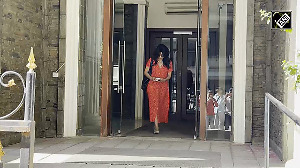The country's top armament scientists on Wednesday got a wake up call from President A P J Abdul Kalam who asked them to "transform" themselves to cope with the need for long-range missiles with proven warheads, nuclear submarines and hypersonic cruise missiles in the next 10 years.
Listing out his strategic vision on what India needed in the next 20 years, Kalam, a leading missile scientist told scientists at his alma mater that they had to gear up to develop pilotless supersonic aircraft, military communication and reconaissance satellites, multi-role stealth fighter aircraft and an internationally competitive advanced main battle tank.
For this, the President delivering a 'special address', said the country's sole Defence Research and Development Organisation had to be completely "reorganised" into a competitive environment.
Kalam's wake up call to the defence scientists comes after Defence Minister A K Antony told them that the nation could ill afford frequent cost and time overruns in the development of missiles, fighters and main battle tanks.
India needs "long-range missile systems in less than 10 years with proper warheads taking into account possible conflict zones," Kalam said.
He said besides these missiles, India would also need hypersonic cruise missiles on long range, nuclear submarines and pilotless supersonic aircraft and also multi-role stealth fighters.
"We also need advanced inter-services integrated electronic radiation hardened warfare systems and high-end cryptography," according to the text of the President's speech.
Security personnel barred newsmen from the function.
Asking Parliament and the government to set a goal for the nation to be 70 per cent self reliant in armament production by year 2020, Kalam called on the DRDO to imbibe competitive culture.
Pointing out that defence scientists were focusing and developing minaturised technologies in the shape of nano, information and biotechnology, the President asked DRDO to offload its widespread basket of system development and to concentrate on strategic and frontier technologies.
"You must look for production partners from both public and private sector establishments from within and outside India," Kalam told the scientists and also called on DRDO to revitalise linkages with universities and advanced institutions on the model of the Joint Advanced Technology Programme.
In an apparent reference to time and cost overruns in major armament programmes, the President told the defence scientists that they should stick to commitments for weapons systems to be delivered to three services and also to production partners.
He advised that DRDO should have have short-term goals for five years and long-term goals of 15 years to develop a vision based on threat perception and technological forecasting.
Kalam, who spoke to young DRDO scientists separately, said 30 per cent of defence scientists, particularly younger ones should concentrate on long-term strategic programmes.
Scramjet technologies, hypersonic dynamics, high mach re-entry heat shield structures, nano computers were other fields identified by the President for DRDO to focus.
He also said that DRDO would have to firm up joint ventures for partners within India and abroad for weapon design development and for production of systems and marketing.
Earlier, the defence minister told the DRDO that more stringent accountability along with greater transparency would have to be enforced in all weapons system development projects.
During the day-long conference, chief controllers of the country's major weapons system projects gave a resume of their projects including development of long-range missiles, efforts to develop missile defence systems, development of cruise missiles and nuclear submarine project.





